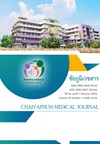ปัจจัยเสี่ยงต่อการเกิดภาวะตกเลือดหลังคลอดในโรงพยาบาลภูเขียวเฉลิมพระเกียรติ จังหวัดชัยภูมิ
คำสำคัญ:
ปัจจัยเสี่ยง, ภาวะตกเลือดหลังคลอดบทคัดย่อ
งานวิจัยนี้เป็นการศึกษาเชิงเปรียบเทียบแบบย้อนหลัง มีวัตถุประสงค์เพื่อศึกษาความชุกและปัจจัยเสี่ยงของภาวะตกเลือดหลังคลอดระยะแรกในหญิงตั้งครรภ์ที่คลอดในโรงพยาบาลภูเขียวเฉลิมพระเกียรติ ระหว่าง 1 มกราคม 2565 - 31 ธันวาคม 2566 จำนวน 508 คน สุ่มตัวอย่างจากเวชระเบียนย้อนหลัง และทะเบียนคลอด โดยเครื่องมือแบบบันทึกข้อมูลหญิงตั้งครรภ์ ตรวจสอบคุณภาพเครื่องมือ ได้ค่าความเชื่อมั่น 0.85 วิเคราะห์ด้วยสถิติพรรณนา และสถิติถดถอยโลจิสติคพหุคูณ
ผลการวิจัย พบว่า หญิงตั้งครรภ์มีภาวะตกเลือดหลังคลอดระยะแรก 71 ราย คิดเป็นความชุก ร้อยละ 14.0 ในจำนวนนี้ ร้อยละ 63.4 เป็นการตกเลือดในระดับความรุนแรงน้อย และปัจจัยเสี่ยงต่อการเกิดภาวะตกเลือดหลังคลอดได้แก่ ภาวะโลหิตจางในระยะคลอด (adj.OR=3.25; 95% CI: 1.29, 8.18) น้ำหนักทารกแรกคลอดสูงกว่าปกติ (adj.OR=12.77; 95% CI: 3.57, 45.62) ความผิดปกติของรก (adj.OR=8.31; 95% CI: 2.14, 32.24) การฉีกขาดของฝีเย็บระดับ 3 ขึ้นไป (adj.OR=32.43; 95% CI: 5.20, 202.49) การคลอดล่าช้าระยะที่ 1 (adj.OR = 4.29; 95% CI: 2.03, 9.03) และ การคลอดล่าช้าระยะที่ 3 (adj.OR=17.46; 95% CI: 2.98, 102.42) ซึ่งสามารถทำนายโอกาสเกิดภาวะตกเลือดหลังคลอดระยะแรก ได้ ร้อยละ 32.3 และการมีค่าดัชนีมวลกายก่อนการตั้งครรภ์สูงกว่าปกติเสี่ยงต่อการเกิดภาวะตกเลือดหลังคลอดน้อยกว่าการมีค่าดัชนีมวลกายก่อนการตั้งครรภ์ปกติ ร้อยละ 72.0
ภาวะตกเลือดหลังคลอดขึ้นอยู่กับปัจจัยหลายอย่าง การให้ความสำคัญกับการประเมินคัดกรองปัจจัยเสี่ยง ตั้งแต่ในระยะตั้งครรภ์ จะเป็นการเฝ้าระวังและรักษาก่อนที่จะเกิดภาวะผิดปกติในหญิงตั้งครรภ์
เอกสารอ้างอิง
Van Stralen G, von Schmidt Auf Altenstadt JF, Bloemenkamp KW, Van Roosmalen J, Hukkelhoven CW. Increasing incidence of postpartum hemorrhage: the Dutch piece of the puzzle. Acta Obstet Gynecol Scand 2016;95(10):1104-10.
เจนีวา ทะวา. อุบัติการณ์และปัจจัยที่มีความสัมพันธ์กับการตกเลือดหลังคลอดในโรงพยาบาลสิงหนคร จังหวัดสงขลา. [ออนไลน์]. 2566. [เข้าถึงเมื่อ 11 กันยายน 2566] เข้าถึงได้จาก https://www.skho.moph.go.th/oa/index.php?page=document
กรมอนามัย. รายงานระบบเฝ้าระวังการตายมารดา ประเทศไทยประจำปีงบประมาณ พ.ศ. 2564. [ออนไลน์]. 2564. [เข้าถึงเมื่อ 11 กันยายน 2566] เข้าถึงได้จาก https://hp.anamai.moph.go.th/th/maternal-mortality-ratio/download?id=90620&mid=30954&mkey=m_document&lang=th&did=28785
กรมอนามัย. ระบบสารสนเทศสนับสนุนงานส่งเสริมสุขภาพและอนามัยสิ่งแวดล้อม. [ออนไลน์]. [เข้าถึงเมื่อ 11 กันยายน 2566] เข้าถึงได้จาก https://dashboard.anamai.moph.go.th/department?year=2023
Cunningham FG, Leveno KJ, Bloom SL, Spong CY, Dashe JS, Hoffman BL, et al. [editor]. Williams obstetrics. 24 th ed. New York: Mcgraw-hill. 2014.
บุษยรัตน์ วงศ์วิริยะเวช, ณัฏฐพร จันทร์แสนโรจน์, และชุติมา เทียนชัยทัศน์. การศึกษาปัจจัยที่ส่งผลต่อการตกเลือดหลังคลอดระยะแรก โรงพยาบาลพระจอมเกล้า จังหวัดเพชรบุรี. วารสารวิทยาลัยพยาบาลพระจอมเกล้า จังหวัดเพชรบุรี 2561;1(1):39-47.
โอทนี สุวรรรมาลี. ปัจจัยเสี่ยงของภาวะโลหิตจางในหญิงตั้งครรภ์ที่คลอดในโรงพยาบาลภูเขียวเฉลิมพระเกียรติ. ราชาวดีสาร วิทยาลัยพยาบาลบรมราชชนนี สุรินทร์ 2566;13(2):81- 98.
ศิริวรรณ วิเลิศ, ทิพวรรณ์ เอี่ยมเจริญ, ดรุณี ยอดรัก. สถานการณ์และปัจจัยที่มีความสัมพันธ์กับการตกเลือดหลังคลอดในมารดาคลอดทางช่องคลอด ในหอผู้ป่วยสูติกรรมสามัญ โรงพยาบาลนพรัตนราชธานี. วารสารพยาบาลสภากาชาดไทย 2559;9(2):173-90.
จิรัสย์พล ไทยานันท์. ความชุก และปัจจัยเสี่ยงต่อการเกิดภาวะตกเลือดระยะแรกในการคลอดทางช่องคลอด ที่โรงพยาบาลมหาวิทยาลัยบูรพา. บูรพาเวชสาร 2566;10(1):1-17.
ถิรนัน สาสุนีย์. ปัจจัยที่มีความสัมพันธ์กับการเกิดภาวะตกเลือดหลังคลอดภายใน 24 ชั่วโมงแรกของหญิงตั้งครรภ์ที่มาคลอดที่โรงพยาบาลโพธาราม จังหวัดราชบุรี. วารสารสุขภาพและสิ่งแวดล้อมศึกษา 2565;7(2):45-56.
Glonnegger H, Glenzer MM, Lancaster L, Barnes RFW, von Drygalski A. Prepartum Anemia and Risk of Postpartum Hemorrhage: A Meta-Analysis and Brief Review. Clin Appl Thromb Hemost 2023:29:10760296231214536.
โรงพยาบาลภูเขียวเฉลิมพระเกียรติ. รายงานประจำปี งานห้องคลอดโรงพยาบาลภูเขียวเฉลิมพระเกียรติ 2563-2566. ชัยภูมิ : งานห้องคลอดโรงพยาบาลภูเขียวเฉลิมพระเกียรติ จังหวัดชัยภูมิ, 2566.
Hsieh FY, Bloch DA, Larsen MD. A simple method of sample size calculation for linear and logistic regression. Stat Med 1998;17(14):1623-34.
จิรัฏฐ์ โตสิบพนม, เฉลิมเกียรติ แซ่เฮ้ง, ณัฐญา เจริญธนโชติ, อภิชญา อนุกูล, กรรณิกา ธิชูโต, ศักดิ์ชัย ไชยมหาพฤกษ์, และคนอื่น ๆ. ปัจจัยเสี่ยงต่อการเกิดภาวะตกเลือดหลังคลอดในระยะแรก. พุทธชินราชเวชสาร 2561;35(1):2-8.
บุญเรียง ขจรศิลป์. วิธีวิจัยทางการศึกษา. (พิมพ์ครั้งที่ 5). กรุงเทพฯ : มหาวิทยาลัยเกษตรศาสตร์. 2543.
ศิริโสภา คำเครือ, ทัศนีย์ ศรีสุวรรณ, รุณราวรรณ์ แก้วบุญเรือง. การพัฒนาแนวปฏิบัติการป้องกันภาวะตกเลือดหลังคลอดระยะแรกในห้องคลอด โรงพยาบาลลำพูน. วารสารการส่งเสริมสุขภาพและอนามัยสิ่งแวดล้อมล้านนา 2561;8(1);46-57.
ณฐนนท์ ศิริมาศ, ปิยรัตน์ โสมศรีแพง, สุพางค์พรรณ พาดกลาง, จุรีพร จักษุจินดา. การพัฒนาระบบการดูแลหญิงตั้งครรภ์ในการป้องกันภาวะตกเลือดหลังคลอดในโรงพยาบาลสกลนคร. วารสารการพยาบาล และการดูแลสุขภาพ 2557;32(2):37-46.
Butwick AJ, Abreo A, Bateman BT, Lee HC, El-Sayed YY, Stephansson O, et al. Effect of maternal body mass index on postpartum hemorrhage. Anesthesiology 2018;128(4),774-83.
ดาวน์โหลด
เผยแพร่แล้ว
ฉบับ
บท
การอนุญาต
ลิขสิทธิ์ (c) 2024 ชัยภูมิเวชสาร

This work is licensed under a Creative Commons Attribution-NonCommercial-NoDerivatives 4.0 International License.





